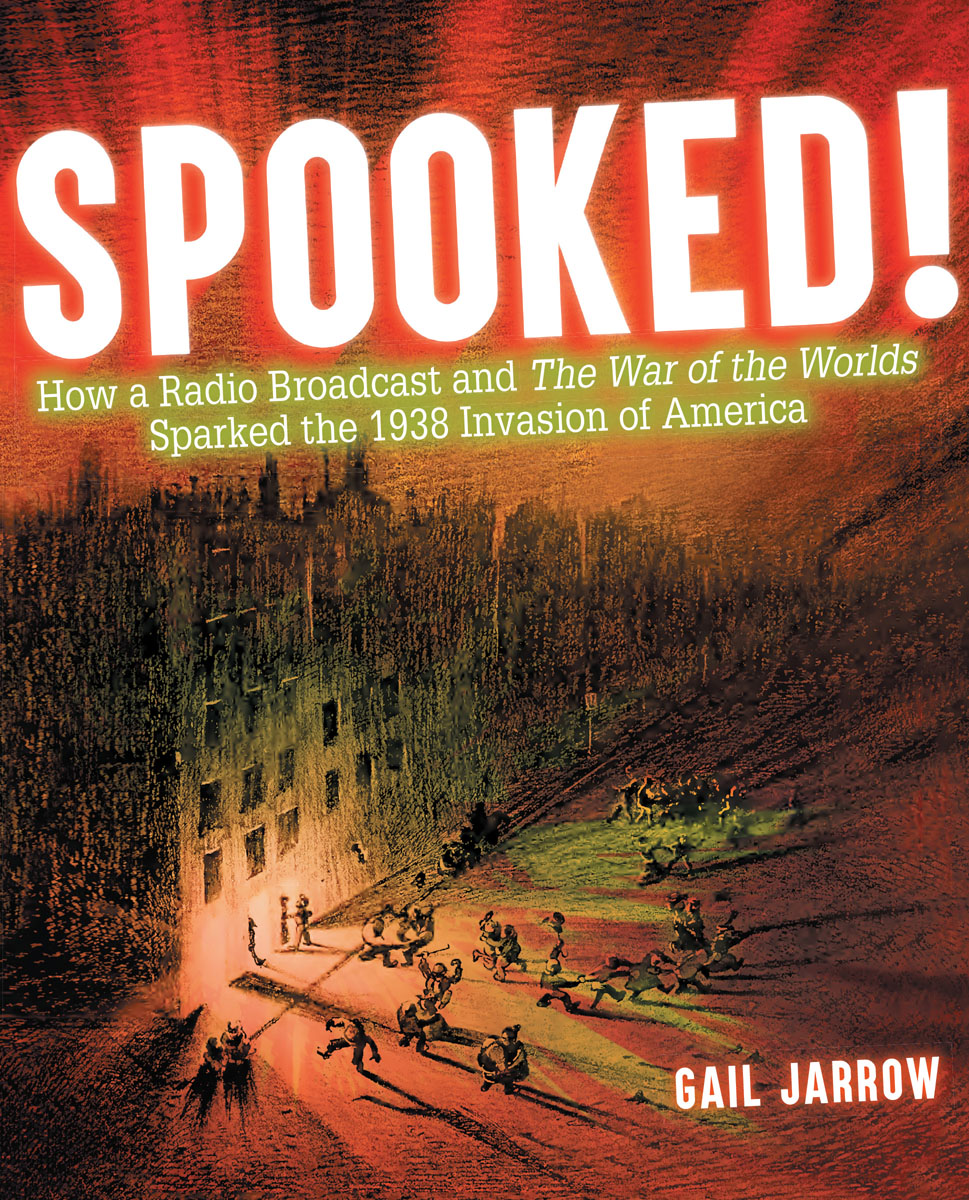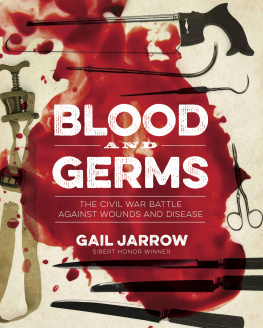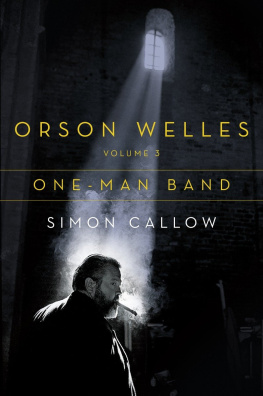
Excerpts from the script of The War of the Worlds radio broadcast reprinted by permission of ICM Partners. Copyright 1940 by Hadley Cantril (In Invasion from Mars), renewed 1967 by Howard Koch.
Text copyright 2018 by Gail Jarrow
All rights reserved. Copying or digitizing this book for storage, display, or distribution is strictly prohibited.
For information about permission to reproduce selections from this book, please contact .
Calkins Creek
An Imprint of Highlights
815 Church Street
Honesdale, Pennsylvania 18431
calkinscreekbooks.com
Printed in China
ISBN: 978-1-62979-776-2 (hc)
ISBN: 978-1-68437-143-3 (eBook)
Library of Congress Control Number: 2018933314
First e-book edition
H1.0
Designed by Red Herring Design
Contents
CHAPTER ONE
HAUNTED ON HALLOWEEN EVE
CHAPTER TWO
MERCURY RISES
CHAPTER THREE
TAKING TO THE AIR
CHAPTER FOUR
BLOOD-RED PLANET
CHAPTER FIVE
PLOTTING THE INVASION
CHAPTER SIX
THE FINAL DAY
CHAPTER SEVEN
THE ATTACK
CHAPTER EIGHT
PANIC
CHAPTER NINE
WRECKAGE
CHAPTER TEN
ITS ALL OVER
CHAPTER ELEVEN
EXTRA! EXTRA! READ ALL ABOUT IT!
CHAPTER TWELVE
FALLOUT
CHAPTER THIRTEEN
TOO DARN REALISTIC
CHAPTER FOURTEEN
SOFT LANDING
For Oona Joan
may you never be Spooked!
Acknowledgments
THANK YOU to these people who shared their time and expertise with me as I worked on this book.
For providing background on human psychology and behavior and for answering my questions about individual responses to media: J. Edward Russo, professor of Marketing, S. C. Johnson Graduate School of Management, Cornell University; and Michael Shapiro, professor, Department of Communication, Cornell University.
For filling me in on key aspects of radio broadcasting and sound production: Tish Pearlman, broadcast journalist and producer; and Nate Richardson, producer and musician.
For providing assistance with primary source research: the staffs at the Special Collections Library, University of Michigan, Ann Arbor; and at the National Archives, College Park, Maryland.
For help in locating and obtaining difficult-to-find photographs: Jeremy Megraw and Thomas Lisanti of the New York Public Library.
For their considerable skill in transforming a manuscript into a published book: the Calkins Creek team.
And for her dependable counsel on all my historical adventures: my trusty editor, Carolyn P. Yoder.
GJ

A family gathers around the radio set. In the 1930s, listening to the radio was Americans favorite entertainment. By 1938, about 80 percent of American homes had a radio.
CHAPTER ONE
HAUNTED ON HALLOWEEN EVE
We figured our friends and families were all dead.
New Jersey college student
Mischief Night 1938 was crisp and clear in the northeastern United States. Following the tradition of the region, teens and older children prowled their neighborhoods. They soaped windows, smashed carved pumpkins, and toilet-papered bushes. The mischief-makers planned to return to the scene of their tricks the next night, Halloween, dressed in costume, innocently asking the neighbors for treats.
Few Americans knew that a group of adults was plotting a different sort of mischief for October 30, 1938.
That Sunday evening began with people gathered around the family radio, relaxing as the weekend drew to a close. On Monday morning, the young would be back at school. Men and some of the women would report to their jobs, if they were lucky enough to have one.
Radio was an escape from the challenges and concerns of their lives. The music, sports, comedy, and drama programs helped them forget the money troubles theyd had since the Great Depression began nine years earlier. Millions were still unemployed, doubtful about ever finding work again. Those with jobs werent sure how long they would keep them. Many had lost their houses and farms because they couldnt pay their debts.
Lately, it seemed as if the bad news wouldnt stop. In September, a powerful hurricane pounded the East Coast from New York through New England. The storm hit without warning, killing about seven hundred people, damaging thousands of homes, and toppling millions of trees.
The ominous developments overseas added to the publics worries. Europe was on edge again just twenty years after the Great War tore it apart. Nations watched warily as Germanys power grew again. The countrys dictator, Adolf Hitler, had broken international treaties and built up his military force. In March 1938, he took control of Austria and, in early October, part of what was then known as Czechoslovakia. Anxious Americans feared what the war-mongering Hitler might do next.
As the Sunday program was about to begin, men leaned back in a favorite chair. Women settled nearby, stitching the final touches onto Halloween costumes. Children who had finished their homework and returned from Mischief Night pranks lay on the floor by the radio set. Someone in the family switched it on and twirled the dial to the evenings entertainment.

During the Great Depression, which began in late 1929, businesses across the United States closed down, putting millions of people out of work. Police in New York City distribute bread and eggs to the unemployed in 1930.

The aftermath of the Hurricane of 1938 in Amherst, Massachusetts. On September 21, the storm devastated the East Coast from New York through New England.
About three minutes into the broadcast, an announcers deep voice suddenly broke in with a special news bulletin. There had been reports of strange, unexplained explosions. The announcer promised that when more details were available, he would pass them on.
The regular program resumed.
Not long after, a commentator informed the audience that he had just been handed a telegram. It said that a shock of almost earthquake intensity had occurred close to Princeton, New Jersey. So far, the cause was unknown.
During the next fifteen minutes, radio listeners throughout the country heard the frightening updates. An invading army had attacked New Jersey. Eyewitnesses described the killings of dozens of peoplestate troopers, innocent bystanders, anyone who stood in the invaders way. The commentator at the scene was hit by a powerful weapon, his entire body charred. New Jerseys state militia was deployed to confront the enemy with seven thousand heavily armed infantry soldiers.
Later, an announcer grimly told the audience that the militia had been overwhelmed in battle. Only 120 of the soldiers survived.
According to accounts, enemy fighters now controlled the middle section of New Jersey. They had cut off communications, pulled down power lines, demolished bridges, and ripped up railroad tracks. Cars full of terrified people streamed onto the highways, trying to escape. Officials declared martial law in New Jersey and parts of Pennsylvania.
Next page












